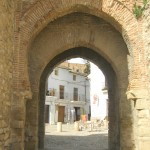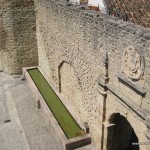A secure city
Part of the reason Ronda is so important in the history of Andalucia directly relates to how secure the city was from attack. The city walls in combination with the gorge and rio Guadalevin made Ronda’s Arab Walls and City Gates impervious from attack until the age of the cannon.
Whilst wooden palisades existed to protect neolithic communities and their successors before the constructions of the Roman castle, the reality is that most of the stone walls around Ronda directly owe their construction to the Islamic era, a period that spanned close to 800 years from 712 until 1485.
Read this article in Spanish here…
Given the absolute impregnability of the gorge and cliffs, the actual length of the city walls didn’t need to be terribly great in the first instance, however as the city expanded down towards the Barrio de San Francisco and into the former Jewish Quarter extra walls needed to be built. Consequently, many of the existing walls around Ronda never did join up, in fact they were originally part of separate encircling rings that no longer exist.
The VoiceMap GPS Audio Guide for Ronda
Information about the defensive walls is included in the VoiceMap GPS Audio Guide for Ronda.
For quite a few years now, the A4 printable guide has been downloading steadily directly from Ronda Today and I have received many hundreds of emails from visitors, who have discovered the very best of a visit to Ronda, using the indepth information made up from the top 20 articles published here at Ronda Today.
But what better way to improve the guide? An audio guide of course!
https://voicemap.me/tour/ronda/ronda-andalucia-s-city-of-dreams-a-walking-tour
The former Jewish Quarter and factory area of Ronda during the Moorish rule of the city no longer exists except for the Arab Baths, a few houses, and the hotel Alavera de los Baños, though it is possible to see where part of the outer wall protecting this district was.
Extending from the Puente Arabe, the original wall snaked between the city houses and factories and the Arab Baths which were always on the outside of the city walls, and then along the edge of the stream until it started turning back toward the fortress on which the church of Espiritu Santo now stands.
A gate used to stand at the city side of the Puente Arabe, this having been the main road to Granada before the new quarter at Padre Jesus was developed in Christian times. As the main entrance to the city, this was considered one of the most critical to defend, and two walls with towers converged at this point.
We can still appreciate how solid those gates might have been when we continue up the path at the base of the inner walls, the Murallas de Levante, to the Puerta de la Cijara. Certainly without cannon it would be impossible to attack the gate and walls without terrible loss of life.
Traders and visitors to Ronda in Moorish times would generally enter the city from the Puente Arabe, and the majority would bathe in the Arab Baths, before visiting a small mosque located next to the gates which probably stood where their is now a small chapel. From there visitors would ascend into the city proper through the Puerte de la Cijara.
On the way along the Murallas de Levante, and before you reach the Espritu Santo church is a short track that leads to the left, and under one of the houses of this street you will see one of the most enigmatic arches, the Puerta de los Esparteros. Believe it or not this used to be one of the gates into the city of Ronda during the Moorish times, though as you can see now it merely part of the foundations of someone’s home.
The only traffic that entered through the gates at Almocabar was from the coast, specifically from the Algeciras/Gibraltar direction, or local farmers and traders who needed to go in that direction. Whilst many have speculated these gates must have been the main entrance to the city due to their grandeur, in fact the square in front of the gates was the town cemetery, the “Al-maqabir”.
Almocabar was also the most heavily defended part of the wall and it was here that the Moorish rulers built their biggest fortress, a large octagonal structure that gave them 360 degree control of both sides of the wall for their longbowmen. The Almocabar gate is now two separate gates, the other being the Charles V gate which bears his coat of arms to this day, next to which you can see a watering trough for horses.
As Spain developed and Christian rule brought about times of peace, Ronda’s role as a vitally important defensive city has diminished. Whilst the Almocabar gate is impressive, it is now only a monument, so the wall only extends from the beginning of the houses surrounding the Espiritu Santo church to the hotel Jardin de la Muralla.
To the north of Ronda, in the direction of Sevilla, and starting at the Guadlevin below the Puente Nuevo, additional defensive walls and gates were built to give a protected route into the city for the flour mills and their workers. In Moorish times the valley below Ronda was a major wheat growing area, and at least 5 or 6 mills were located along the river to grind the wheat.
Sadly in the early 20th century a rock fall from above destroyed all of the mills, however they were already becoming a relic of the past as 20th century industrial engineering was making them redundant. At least two of the mills can still be seen and appreciated, start by making your way to the Puerta de los Molinos (visible from the Parador Hotel terrace walk, the Puente Nuevo, and the Casa Don Bosco gardens), and then follow the narrow walking track back to the base of the Puente Nuevo.
It is possible to walk under the bridge, but you will also see a small aqueduct running along the edge of the tajo gorge which is still in excellent condition and was used to provide water to the mills for turning their grinding stones. One of the ruined mills still has a domed ceiling and the stones remain in place.
In the days of the mills, the existing walking track from the Plaza Maria Auxiliadora was only useful for workers or travellers entering the city, but the majority of traffic through the Puerta de los Molinos were carts bringing wheat to be ground, so an easier route was built, and of course a new wall had to be built. This particular wall only ever extended as far as the Puerta del Viento, and is called the Murallas de Poniente, though many people only know it because of the rocky point extending into the sky which is jokingly called “El Pene”.
Ronda’s Gates and Walls Photos
Ronda Today
Everything you need to know before you visit Ronda “The city of dreams” in Andalucia. https://www.rondatoday.com/
The Caminito del Rey
Find tickets for the Caminito del Rey: https://www.caminodelrey.es/
Wildside Holidays – Spain
Take a trip on the Wildside! Discover the wildlife and nature of Spain, its Natural and National Parks and find the top wildlife, activity and walking holiday companies.
Visit Cádiz
Planning on visiting Cádiz? Tourist information. Monuments. Hotels. Activities. City guides. https://visitingcadiz.com/





















